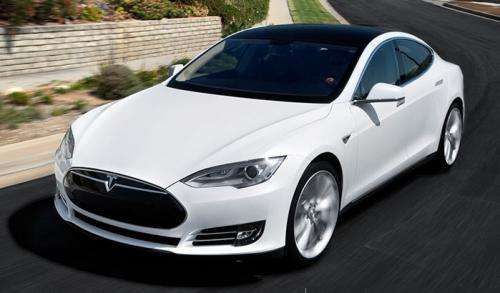Building a better battery

Imagine an electric car with the range of a Tesla Model S - 265 miles - but at one-fifth the $70,000 price of the luxury sedan. Or a battery able to provide many times more energy than today's technology at significantly lower prices, meaning longer-lasting and less expensive power for cellphones, laptops and the home.
Those are among the goals of a $120 million, Department of Energy-funded Joint Center for Energy Storage Research, a 14-member partnership led by Argonne National Laboratory and including Lawrence Berkeley Lab, Sandia National Laboratories and several universities and private companies. In January, the center's Berkeley hub is moving into the lab's new $54 million General Purpose Laboratory, bringing its battery scientists, chemists and engineers together under one roof for the first time.
The team, headed by center Deputy Director Venkat Srinivasan, aims to achieve revolutionary advances in battery performance - creating devices with up to five times the energy capacity of today's batteries at one-fifth the cost by 2017.
To accomplish the feat, Srinivasan is looking to replace the current standard-bearer for rechargeable batteries - lithium-ion - with batteries made of cheaper, more durable materials, including magnesium, aluminum and calcium.
"We want to go beyond and find the next generation of technology," Srinivasan said. "It's clear to us that the batteries we have today are not meeting the needs."
While private companies such as Tesla and Toyota are working to improve on lithium-ion technology, in the United States it's the government labs that are trying to move technology to the next level.
George Crabtree, director of the project at Argonne National Laboratory near Chicago, said the federal government is pursuing the research to transform the two areas that consume two-thirds of all the energy generated in the United States - transportation and the energy grid. If successful, Crabtree said, consumers would benefit from cheaper electric cars and less dependence on utility companies for power at home.
"There's a real opportunity for next-generation storage," Crabtree said. "You have to make a big step forward. Lithium-ion will not be able to make that step. ... You need a big program and a group effort to make it happen."
Nearly two years into the project, Crabtree said, researchers have narrowed down a list of about 100 types of "beyond lithium-ion" batteries to a few of promising concepts that are already in the prototype phase.
To reach the Obama administration's goals of producing a quarter of all the nation's electricity from solar and wind by 2025, and having 1 million all-electric vehicles on the road in the coming years, consumers will need cheaper batteries with a higher energy density, faster charging time and more range, Srinivasan said. A battery costing $100 per kilowatt hour - three to five times less than today's technology - would make electric vehicles and renewable energy affordable to the masses.
"Energy storage is a linchpin of the future," Srinivasan said. "Today's batteries are kind of expensive. How do we get it to the point where the battery can pay for itself? That's the target we're shooting for."
Sharing the new state-of-the-art General Purpose Laboratory will be principal investigator and Lawrence Berkeley staff scientist Brett Helms, who is focusing his research on rechargeable flow batteries, which store energy in a liquid solution of electrolytes that can be pumped through a membrane, generating power when they circulate and react with electrodes.
Helms wants to use more cost-effective materials such as sulfur - a plentiful byproduct of refining crude oil - to create a battery with five to 10 times more energy than current flow batteries, at a much lower cost. Combined with solar panels and wind farms, big high-density battery packs could store most of the energy generated for use at a later time, providing an uninterrupted power supply in homes day or night, rain or shine, allowing homeowners to go off the grid and access the energy at any time.
This would overcome one of the main problems with renewable systems: They can produce energy only when the conditions - sun or wind - are right, not necessarily when the energy is needed, as fossil fuel-fired generators do.
"We're producing all of this energy, but where is it going to go and how is it going to be integrated into the grid?" Helms said. "The biggest concern is to take advantage of the investment we've been making in the renewables. If we don't have an energy storage solution, we will have wasted that investment."
Helms' team is developing a membrane for the flow battery that would increase its durability and enable the battery to cycle, or charge, better. He aims to have a working prototype of a lithium-sulfur flow battery - the first of its kind - by the end of the five-year project. The technology, he said, could also someday power electric vehicles.
"We've done battery work in the past, but thinking about national problems with people all over the country is an amazing opportunity," Helms said.
The future home of Berkeley's battery research hub is next door to the Advanced Light Source building, where automaker Toyota has been researching magnesium-ion batteries.
Lithium-ion batteries have a charge of plus-1, providing a single electron per electrical current. Magnesium has a charge of plus-2.
"For the same weight, you can have twice the charge - you're doubling the amount of capacity," Srinivasan said. "That's exciting."
Using high-performance computing, Srinivasan's team has whittled down the number of materials to a few that have sufficient energy capacity and can be classified as safe, cheaper and longer-lasting than lithium. Within the next year, Srinivasan hopes to have other new materials ready for testing, and optimized prototypes ready by 2017.
(c)2014 Contra Costa Times (Walnut Creek, Calif.)
Distributed by Tribune Content Agency, LLC




















